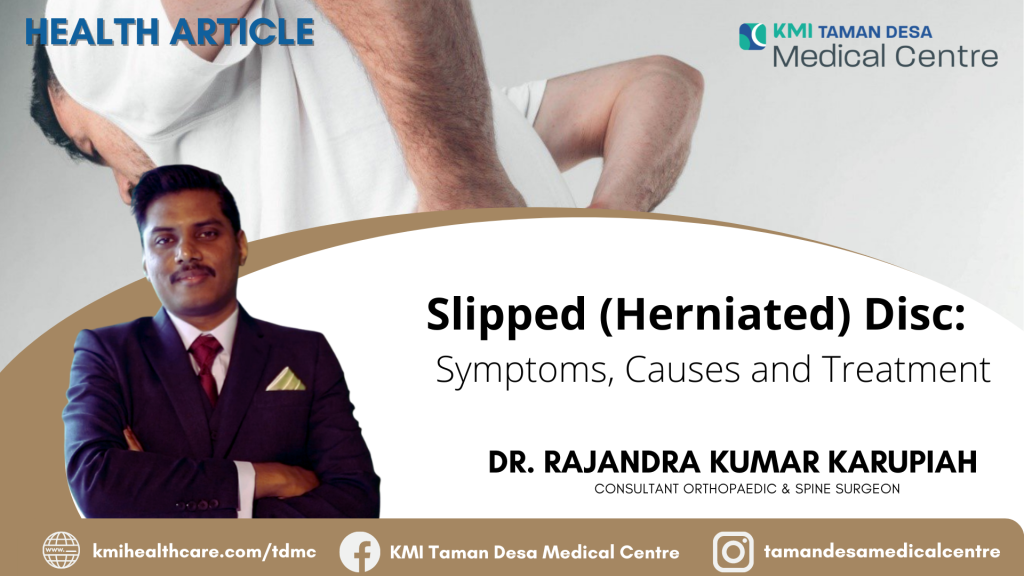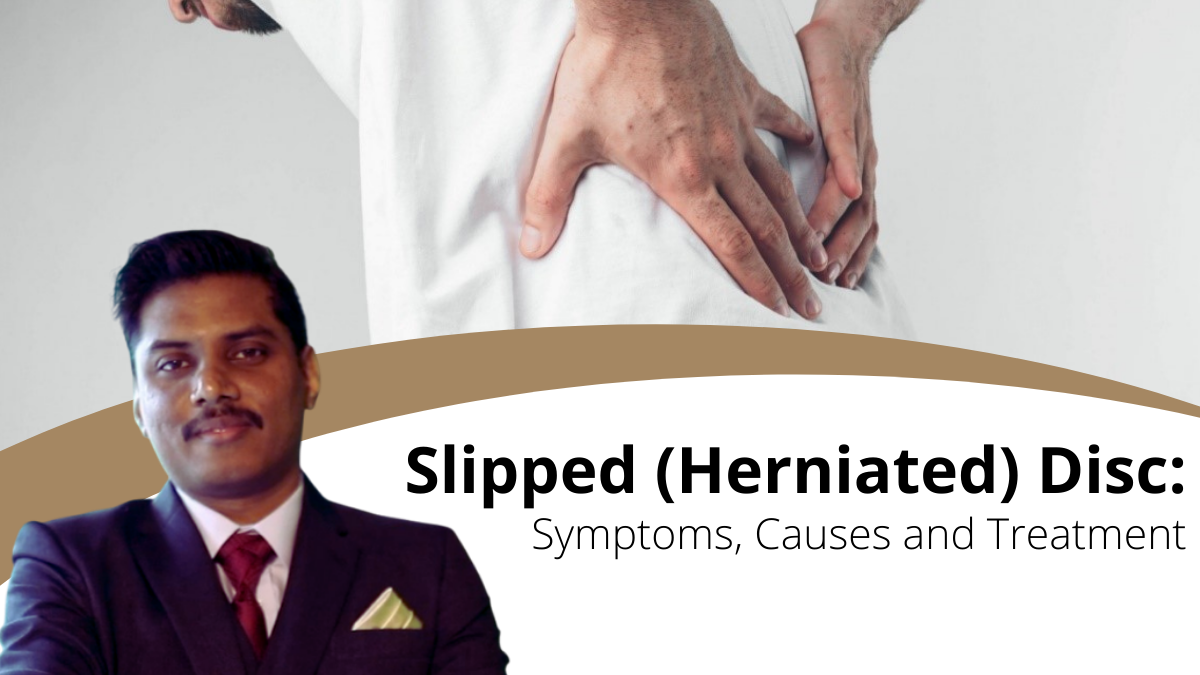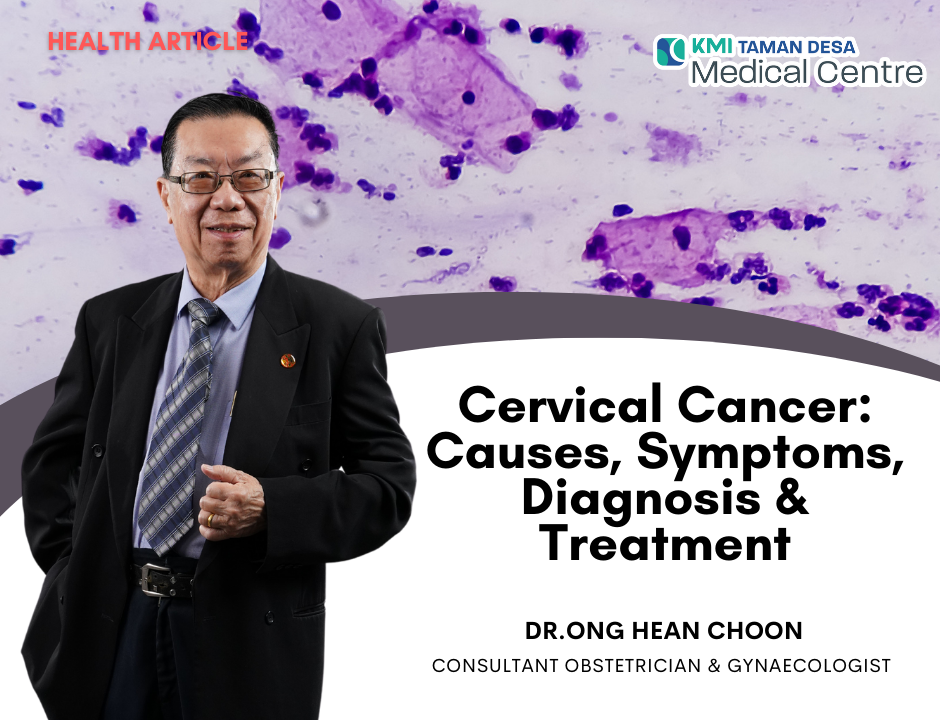[TDMC]- Slipped (Herniated) Disc: Symptoms, Causes, And Treatment 

[TDMC]: Physiotherapy @ KMI-Taman Desa Medical Centre
26 January 2022
[TDMC]-Colorectal Cancer Awareness
28 February 2022
Your “spine” is not just a flexible, solid piece supporting your body. It is actually made up of small moving parts stacked up on top of each other, called vertebrae, that have to work together in order to provide support to your spinal cord. The key players responsible for holding together the vertebrae are your cushion-like pads, aka discs. Any damage or injury to these discs results in slipped or herniated discs, causing discomfort and pain.
This article covers important information about the slipped disc, its causes, and how it is diagnosed.
What Is A Slipped Disc?
The spinal discs that cushion the vertebrae are small, fibrocartilaginous tissues that act as shock absorbers for the spinal bones during activities like twisting, lifting, and walking. Each disc has two parts: a soft, gel-like interior of the disk (nucleus pulposus) protected by a tough outer ring called the annulus.
A slipped disc is a condition in which the inner portion of the disc is pushed out of the annulus (the tough outer ring) due to pressure or stress caused by an injury or trauma to the discs. Usually, a slipped disc is in the early stages of disc degeneration. The limited space in the spinal canal becomes insufficient for the slipped disc and the spinal nerve. This causes the slipped disc to compress one of the spinal nerves, resulting in severe pain, discomfort, and numbness [1].
A slipped disc can affect any part of the spine, mainly the cervical spine (neck) and the lumbar spine (lower back).
What Are The Symptoms Of A Slipped Disc?
Signs and symptoms of a slipped disc depend on the location of the disc and whether the disc is compressing a nerve. Usually, a slipped disc mostly affects the neck and lower back because they’re the flexible parts of the spine and allow most movements. Therefore, they’re more prone to wear and tear.
Common symptoms of a slipped disc include:
Pain extending to the legs and arms.
Pain felt while walking short distances.
Weakness in the leg or foot.
Pain that gets worse after sitting or standing.
Unexplained muscle weakness.
A tingling sensation and numbness in the leg and foot.
Sciatica: This is characterized by a shooting pain radiating along the sciatic nerve.
Loss of bowel or bladder control. This is an extremely rare condition [2].
What Are The Causes Of A Slipped Disc?
Common causes of a slipped disc include:
· Ageing: One of the most common causes of a slipped disc is the age-related wear and tear of the spine, called disc degeneration. With age, the discs become less flexible due to a decrease in the water content [3].
· Trauma: Another cause for a slipped disc is trauma as a result of heavy lifting and twisting. An overstressed disc is more prone to rupture in case of high-impact trauma, like a car accident. A physically demanding job also causes a slipped disc also puts stress on the discs.
Other risk factors that increase your risk of a slipped disc include:
· Obesity: Being overweight puts extra stress on the discs in the lower back [4].
· Gender: Men aged between 20 to 50 are more at risk of slipped discs.
· Smoking: Smoking reduces oxygen supply to the disc, leading to rapid degeneration [5].
· Sedentary Lifestyle: Being physically inactive leads to the development of a slipped disc.
How Are Slipped Discs Diagnosed?
Based on your medical history and symptoms, your doctor performs a physical exam to look for the source of pain, loss of sensation, and muscle weakness.
A straight leg raise (SLR) test can also be used to diagnose a slipped disc. During this test, the doctor indicates a slipped disc by lifting the affected leg by keeping your knee straight.
Specific imaging tests can also diagnose a slipped disc:
-MRI scans
-CT scan
-X-ray
-Discograms
-Myelogram
Treatment Options For Slipped Discs:
There are both conservative, as well as surgical options for treating a slipped disc. Moreover, the treatment also depends on the extent of a slipped disc and the level of discomfort you’re experiencing.
OTC Medications: Over-the-counter medications, such as naproxen sodium, acetaminophen, and ibuprofen, can help relieve mild to moderate pain resulting from a slipped disc.
Rest: Back and leg pain associated with a slipped disc can also be relieved from two to three days of rest. When you resume activities, you should avoid sitting for a prolonged time and taking rest breaks throughout the day.
Exercise: Your physical therapist may also recommend an exercise program to strengthen the lower back and abdominal muscles.
Epidural Steroid Injections: If oral medications aren’t effective in relieving pain, epidural steroid injection (corticosterone-like drugs) is injected in the area around the spinal nerves.
Muscle Relaxers: If you have muscle spasms, your doctor will prescribe you muscle relaxers, but they cause dizziness and sedation [6].
Percutaneous Laser Disc Decompression: Percutaneous laser disc decompression (PLDD) is a procedure in which herniated intervertebral discs are treated by reduction of intradiscal pressure through laser energy.
Surgery may also be recommended when non-surgical treatments are not effective after six weeks, and you still experience:
I) Difficulty walking
II) Muscle weakness
III) Poorly controlled pain
IV) Loss of bowel or bladder control.
Microdiscectomy: In this procedure, the protruding part of the slipped disc is removed through a small incision [7].
What Are The Complications Of A Slipped Disc?
The following are some complications of an untreated slipped disc:
Permanent Nerve Damage: If you have an untreated, severe slipped disc leads to permanent damage of the spinal nerves. In extremely rare cases, you may lose your bladder or bowel control when a slipped disc compresses the cauda equina nerves, leading to cauda equina syndrome.
Saddle Anesthesia: This is another complication that occurs when the slipped disc compresses spinal nerves, leading to the loss of sensation around your rectum, the back of the legs, and inner thighs.
How To Prevent Slipped Discs?
Below are some preventive tips to avoid the risk of slipped discs and protect the spine:
A) Losing weight to reduce extra stress from the spine and spinal discs.
B) Quitting smoking to slow down the rate of disc degeneration.
C) Exercising regularly strengthens the legs and lower back muscles because these muscles support your spine.
D) Practising good posture.
Conclusion:
If left unchecked, a slipped disc may cause many complications, such as permanent nerve damage and inability to walk—usually, non-surgical treatment options, such as over-the-counter medications, exercise, and rest. A very small percentage of people with slipped discs are recommended surgery.
By: Dr. Rajandra Kumar Karupiah
Consultant Orthopaedic & Spine Surgeon
KMI-Taman Desa Medical Centre
References:
1. Amin RM, Andrade NS, Neuman BJ. Lumbar Disc Herniation. Curr Rev Musculoskelet Med 2017;10:507–16. https://doi.org/10.1007/s12178-017-9441-4.
2. Elshani B, Krasniqi S, Gjyliqi R. Herniated Lumbar Disc and Nursing Care. Int J Bus Technol 2018;6:1–8. https://doi.org/10.33107/ijbte.2018.6.2.01.
3. Schroeder GD, Guyre CA, Vaccaro AR. The epidemiology and pathophysiology of lumbar disc herniations. Semin Spine Surg 2016;28:2–7. https://doi.org/https://doi.org/10.1053/j.semss.2015.08.003.
4. Li Y, Shi J-J, Ren J, Guan H-S, Gao Y-P, Zhao F, et al. [Relationship between obesity and lumbar disc herniation in adolescents]. Zhongguo Gu Shang 2020;33:725–9. https://doi.org/10.12200/j.issn.1003-0034.2020.08.008.
5. Lener S, Wipplinger C, Hartmann S, Thomé C, Tschugg A. The impact of obesity and smoking on young individuals suffering from lumbar disc herniation: a retrospective analysis of 97 cases. Neurosurg Rev 2020;43:1297–303. https://doi.org/10.1007/s10143-019-01151-y.
6. Dydyk AM, Ngnitewe Massa R, Mesfin FB. Disc Herniation. Abrazo Central Campus: StatPearls Publishing, Treasure Island (FL); 2021. https://europepmc.org/article/med/28722852
7. Heider FC, Mayer HM. [Surgical treatment of lumbar disc herniation]. Oper Orthop Traumatol 2017;29:59–85. https://doi.org/10.1007/s00064-016-0467-3.
8. D S Choy. Percutaneous laser disc decompression (PLDD): twelve years’ experience with 752 procedures in 518 patients. Journal of Clinical Laser Medicine and Surgery, Vol 16, No. 6. https://www.liebertpub.com/doi/10.1089/clm.1998.16.325




